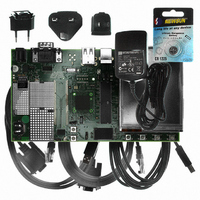AT91SAM9G10-EK Atmel, AT91SAM9G10-EK Datasheet - Page 279

AT91SAM9G10-EK
Manufacturer Part Number
AT91SAM9G10-EK
Description
KIT DEV FOR SAM9G10 ARM
Manufacturer
Atmel
Type
MCUr
Specifications of AT91SAM9G10-EK
Contents
Board, Cables, Power Supply
Silicon Manufacturer
Atmel
Core Architecture
AVR
Kit Contents
Board
Svhc
No SVHC (15-Dec-2010)
Mcu Supported Families
AT91SAM9G10, ARM926EJ-S
Tool / Board Applications
Microcontroller
Rohs Compliant
Yes
For Use With/related Products
*
Lead Free Status / RoHS Status
Contains lead / RoHS non-compliant
- Current page: 279 of 730
- Download datasheet (12Mb)
6462A–ATARM–03-Jun-09
It is assumed that:
When nIRQ is asserted, if the bit “I” of CPSR is 0, the sequence is as follows:
Note:
1. The Advanced Interrupt Controller has been programmed, AIC_SVR registers are
2. The instruction at the ARM interrupt exception vector address is required to work with
1. The CPSR is stored in SPSR_irq, the current value of the Program Counter is loaded in
2. The ARM core enters Interrupt mode, if it has not already done so.
3. When the instruction loaded at address 0x18 is executed, the program counter is
4. The previous step has the effect of branching to the corresponding interrupt service
5. Further interrupts can then be unmasked by clearing the “I” bit in CPSR, allowing re-
6. The interrupt handler can then proceed as required, saving the registers that will be
7. The “I” bit in CPSR must be set in order to mask interrupts before exiting to ensure that
8. The End of Interrupt Command Register (AIC_EOICR) must be written in order to indi-
LDR PC, [PC, # -&F20]
loaded with corresponding interrupt service routine addresses and interrupts are
enabled.
the vectoring
the Interrupt link register (R14_irq) and the Program Counter (R15) is loaded with 0x18.
In the following cycle during fetch at address 0x1C, the ARM core adjusts R14_irq, dec-
rementing it by four.
loaded with the value read in AIC_IVR. Reading the AIC_IVR has the following effects:
– Sets the current interrupt to be the pending and enabled interrupt with the highest
– De-asserts the nIRQ line on the processor. Even if vectoring is not used, AIC_IVR
– Automatically clears the interrupt, if it has been programmed to be edge-triggered.
– Pushes the current level and the current interrupt number on to the stack.
– Returns the value written in the AIC_SVR corresponding to the current interrupt.
routine. This should start by saving the link register (R14_irq) and SPSR_IRQ. The link
register must be decremented by four when it is saved if it is to be restored directly into
the program counter at the end of the interrupt. For example, the instruction SUB PC,
LR, #4 may be used.
assertion of the nIRQ to be taken into account by the core. This can happen if an inter-
rupt with a higher priority than the current interrupt occurs.
used and restoring them at the end. During this phase, an interrupt of higher priority
than the current level will restart the sequence from step 1.
the interrupt is completed in an orderly manner.
cate to the AIC that the current interrupt is finished. This causes the current level to be
popped from the stack, restoring the previous current level if one exists on the stack. If
another interrupt is pending, with lower or equal priority than the old current level but
with higher priority than the new current level, the nIRQ line is re-asserted, but the inter-
rupt sequence does not immediately start because the “I” bit is set in the core.
SPSR_irq is restored. Finally, the saved value of the link register is restored directly into
the PC. This has the effect of returning from the interrupt to whatever was being exe-
cuted before, and of loading the CPSR with the stored SPSR, masking or unmasking
the interrupts depending on the state saved in SPSR_irq.
priority. The current level is the priority level of the current interrupt.
must be read in order to de-assert nIRQ.
If the interrupt is programmed to be level sensitive, the source of the interrupt must be cleared dur-
ing this phase.
AT91SAM9G10
279
Related parts for AT91SAM9G10-EK
Image
Part Number
Description
Manufacturer
Datasheet
Request
R

Part Number:
Description:
MCU, MPU & DSP Development Tools KICKSTART KIT FOR AT91SAM9 PLUS
Manufacturer:
IAR Systems

Part Number:
Description:
DEV KIT FOR AVR/AVR32
Manufacturer:
Atmel
Datasheet:

Part Number:
Description:
INTERVAL AND WIPE/WASH WIPER CONTROL IC WITH DELAY
Manufacturer:
ATMEL Corporation
Datasheet:

Part Number:
Description:
Low-Voltage Voice-Switched IC for Hands-Free Operation
Manufacturer:
ATMEL Corporation
Datasheet:

Part Number:
Description:
MONOLITHIC INTEGRATED FEATUREPHONE CIRCUIT
Manufacturer:
ATMEL Corporation
Datasheet:

Part Number:
Description:
AM-FM Receiver IC U4255BM-M
Manufacturer:
ATMEL Corporation
Datasheet:

Part Number:
Description:
Monolithic Integrated Feature Phone Circuit
Manufacturer:
ATMEL Corporation
Datasheet:

Part Number:
Description:
Multistandard Video-IF and Quasi Parallel Sound Processing
Manufacturer:
ATMEL Corporation
Datasheet:

Part Number:
Description:
High-performance EE PLD
Manufacturer:
ATMEL Corporation
Datasheet:

Part Number:
Description:
8-bit Flash Microcontroller
Manufacturer:
ATMEL Corporation
Datasheet:

Part Number:
Description:
2-Wire Serial EEPROM
Manufacturer:
ATMEL Corporation
Datasheet:










